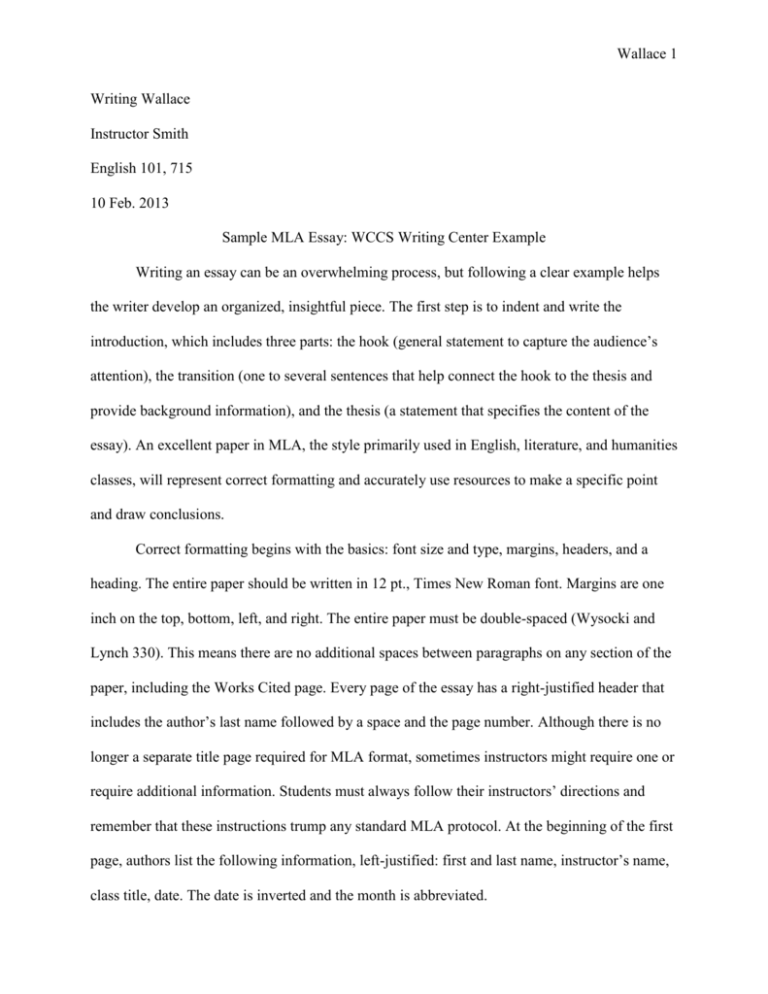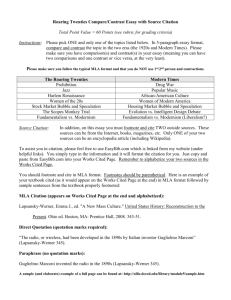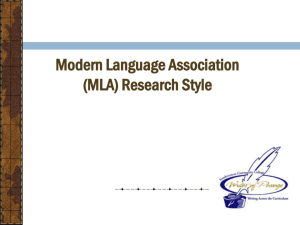Sample MLA Essay: Formatting & Citation Guide
advertisement

Wallace 1 Writing Wallace Instructor Smith English 101, 715 10 Feb. 2013 Sample MLA Essay: WCCS Writing Center Example Writing an essay can be an overwhelming process, but following a clear example helps the writer develop an organized, insightful piece. The first step is to indent and write the introduction, which includes three parts: the hook (general statement to capture the audience’s attention), the transition (one to several sentences that help connect the hook to the thesis and provide background information), and the thesis (a statement that specifies the content of the essay). An excellent paper in MLA, the style primarily used in English, literature, and humanities classes, will represent correct formatting and accurately use resources to make a specific point and draw conclusions. Correct formatting begins with the basics: font size and type, margins, headers, and a heading. The entire paper should be written in 12 pt., Times New Roman font. Margins are one inch on the top, bottom, left, and right. The entire paper must be double-spaced (Wysocki and Lynch 330). This means there are no additional spaces between paragraphs on any section of the paper, including the Works Cited page. Every page of the essay has a right-justified header that includes the author’s last name followed by a space and the page number. Although there is no longer a separate title page required for MLA format, sometimes instructors might require one or require additional information. Students must always follow their instructors’ directions and remember that these instructions trump any standard MLA protocol. At the beginning of the first page, authors list the following information, left-justified: first and last name, instructor’s name, class title, date. The date is inverted and the month is abbreviated. Wallace 2 Bolding and italics are additional aspects of formatting that are often misused. In MLA, only first and third-level headings are bolded—and only for formatted, not numbered, headings. The widely recognized Purdue Online Writing Lab (Purdue OWL) provides examples of how to format these headings (Russell, Brizee, and Angeli). Purdue OWL also provides the following guidelines for using italics in the title of an essay: “Use quotation marks and/or italics when referring to other works in your title, just as you would in your text” (Russell, Brizee, Angeli). Italics are used according to standard rules, such as for the titles of larger works, paintings, foreign words, etc. Many students are tempted to overuse bolding and italics because of stylistic purposes, but it is important to follow proper MLA rules. Most papers written in MLA formatting require extensive research. Unfortunately, many students inaccurately use resources, often leading to confusing information and, worse, unintentional plagiarism. Plagiarism is using someone else’s ideas or structural patterns without giving the author proper credit. In order to avoid plagiarism, writers must remember that any time they refer to information they did not know prior to conducting research, they must cite their sources (Wysocki and Lynch 293). Citation can be direct or indirect. Direct citation, using the exact wording of a source, requires putting these borrowed words in quotation marks and providing in-text documentation about the author, the page number, and other pertinent information to correspond with the Works Cited page. (Note: This essay capitalizes Works Cited to denote correct punctuation of the document itself.) However, if direct citations are longer than four lines of prose or three lines of poetry, format them according to these rules: [P]lace quotations in a free-standing block of text and omit quotation marks. Start the quotation on a new line, with the entire quote indented one inch from the left margin; maintain double-spacing. Only indent the first line of the quotation by an Wallace 3 additional quarter inch if you are citing multiple paragraphs. Your parenthetical citation should come after the closing punctuation mark. (Russel, Brizee, and Angeli) Wallace’s Write Now! The DK Handbook offers specific examples of how to properly cite sources. According to this handbook, “The overall purpose of an in-text citation is to help readers see your cited sources for themselves. . . .In-text citations also help give your writing authority” (Wysocki & Lynch 342). Indirect citations—a paraphrase or summary of someone else’s ideas—also require full citation; the only citation difference is that they do not include quotation marks. In-text citation is vital to properly documenting sources and avoiding plagiarism. Anytime an author borrows someone else’s ideas, phrasing, or sentence structure, the author must provide correct citation. The Works Cited list complements the in-text citations and provides full information for each source used so readers can easily locate the original sources. When compiling a Works Cited list, students must include four general categories of information: the author’s name, the title of the text, the publication of the text, and the medium (Wysocki and Lynch 352). Pages 353-365 in Write Now! The DK Handbook provide a starting place for correct documentation for the Works Cited page (Wysocki and Lynch). Entries are alphabetized by the first word, always the source’s author unless there is no author. In this case, entries are listed by the title of the work. Entries are formatted using hanging indentation to help the reader easily locate each source. This essay’s Works Cited list includes a web-based source and a print source, both excellent resources for writing any type of research paper in MLA format. Page 355 in Write Now! The DK Handbook offers additional examples of a Works Cited page in MLA format (Wysocki and Lynch). Wallace 4 Writing a research paper can feel like a daunting task, but clear formatting and correct use of resources will help the writer clearly communicate his or her ideas. These papers are an opportunity to gather and synthesize existing information, while also drawing new conclusions and helping challenge people to think and act differently. Research writing is a valuable learning tool for both the student and the reader. Wallace 5 Works Cited Russell, Tony, Allen Brizee, and Elizabeth Angeli. "MLA Formatting and Style Guide." The Purdue OWL. Purdue U Writing Lab, 9 May 2012. Web. 22 Jan. 2013. Wysocki, Anne Frances and Dennis Lynch. Write Now! The DK Handbook with Exercises. Boston: Pearson, 2013. Print.






